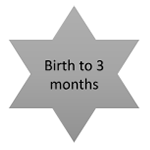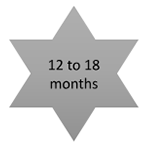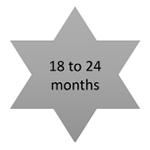Growth and Developmental Guide: Oro-Motor Milestones
Oro-motor milestones refer to the development stages related to the movements of the muscles of the mouth, face, jaw, which are essential for activities such as sucking, chewing, swallowing, and speaking. These milestones are crucial for feeding, speech development, and overall oral-motor function. Here is a general overview of oro-motor milestones by age:

- Sucking Reflex: Babies are born with a strong sucking reflex, which is essential for feeding. Newborns can suck and swallow efficiently.
- Rooting Reflex: When the baby’s cheek is touched, they will turn their head and open their mouth to seek the nipple or bottle.
- Jaw Movements: The jaw begins to move up and down rhythmically during sucking.
- Tongue Movements: The tongue moves forward and backward to help draw liquid into the mouth

- Increased Lip Closure: The baby starts to develop better control of their lips, helping them form a tighter seal around the nipple or bottle.
- More Coordinated Sucking and Swallowing: The baby becomes more efficient at coordinating sucking, swallowing, and breathing during feeding.
- Introduction of Pureed Foods: Around 4-6 months, babies begin to explore pureed foods. They start learning to move food from the front to the back of their mouth for swallowing.
- Early Babbling: The baby may begin to experiment with sounds, such as cooing and early babbling (e.g. “ba” or “ma”), which are precursors to speech.
- Chew toys can be a great pacifier distraction or training tool to help babies transition to shorter suck duration, delaying pacifier time as long as possible

- Chewing Movements: The baby starts to develop a basic chewing pattern, with up-and-down jaw movements. They may begin to chew on soft, solid foods.
- Tongue Control: The tongue starts to move from side to side, aiding in the movement of food within the mouth.
- Improved Lip and Jaw Control: Babies gain more control over their lips and jaw, helping them keep food in their mouth and improving feeding skills.
- Increased Babbling: Babies begin to produce more varied sounds and combinations of consonants and vowels (e.g. “baba”, “dada”), laying the foundation for speech.
- First Teeth: Teething starts with the eruption of the lower anterior central incisors follow by the upper two centrals. The eruption of new teeth will help outline the tongue’s boundary.

- More Advanced Chewing: Babies begin to use a combination of up-and-down and rotary (circular) jaw movements for more effective chewing of solid foods.
- Biting: They can start to bite pieces of food rather than just suck or mash.
- Pincer Grasp: The development of the fine motor skills, like the pincer grasp, allows babies to pick up small pieces of food and feed themselves.
- First Words: Around 12 months, babies may start to say their first words, indicating further development of oro-motor skills related to speech.
- Oral Sensory Input: The mouth receives 1/3 of all sensory information relayed to the brain for processing.

- Rotary Chewing: The development of rotary (circular) chewing movements becomes more refined, allowing for more efficient chewing of a variety of textures.
- Drinking from a Cup: Babies typically transition from bottles to open cups or sippy cups, requiring better lip and tongue control.
- Increasing Speech: As the oro-motor system continues to develop, toddlers start using more words and phrases, demonstrating increasing coordination of the mouth and facial muscles for speech.

- Mature Chewing Patterns: By 24 months, children should have developed mature chewing patterns, with coordinated jaw, tongue, and lip movements, allowing them to handle a wide variety of solid foods.
- Refined Speech Movements: Speech becomes clearer, with improved control over the muscles required for articulation, including the lips, tongue and jaw.
- Straw Drinking: Many children can drink from a straw by this age, which requires specific coordination of the lips, tongue and cheeks. Child should be able to demonstrate nasal breathing and chewing with their mouth closed
- Full Primary Dentition: By 2 years of age, most kids have their 2nd molars and full primary dentition stablished, enabling them to perform more complex rotary chew actions

- Refinement of Oro-Motor Skills: Oro-motor control continues to improve, supporting more complex speech and language development.
- Increased Independence with Eating: Children become more proficient at self-feeding, using utensils, and managing different textures of foods.

- Full Development of Oro-Motor Skills: By this age, most children have fully developed oro-motor skills necessary for eating a wide variety of foods, speaking clearly, and engaging in oral activities such as blowing, licking, and chewing gum.
- Advanced Speech Sounds: Children should be able to produce most speech sounds correctly, though some more complex sounds (e.g. “r”, “th”) may still be developing.
Importance of Monitoring Oro-Motor Milestones:
Delays in these milestones could indicate underlying issues, such as orofacial myofunctional disorders, feeding difficulties, or speech and language delays. Early intervention through speech therapy, occupational therapy, or feeding therapy can help address these issues.
If there are concerns about your child’s oro-motor development, it's important to consult with your pediatric dentist, pediatrician or orofacial myofunctional therapist.